Key takeaways:
- Database normalization reduces redundancy and improves data integrity, akin to organizing a cluttered space for better clarity and efficiency.
- Understanding and defining functional dependencies is crucial for creating a clean database structure, enhancing both performance and data integrity.
- Testing and refining the database design through user feedback and performance adjustments leads to a more intuitive and efficient user experience.
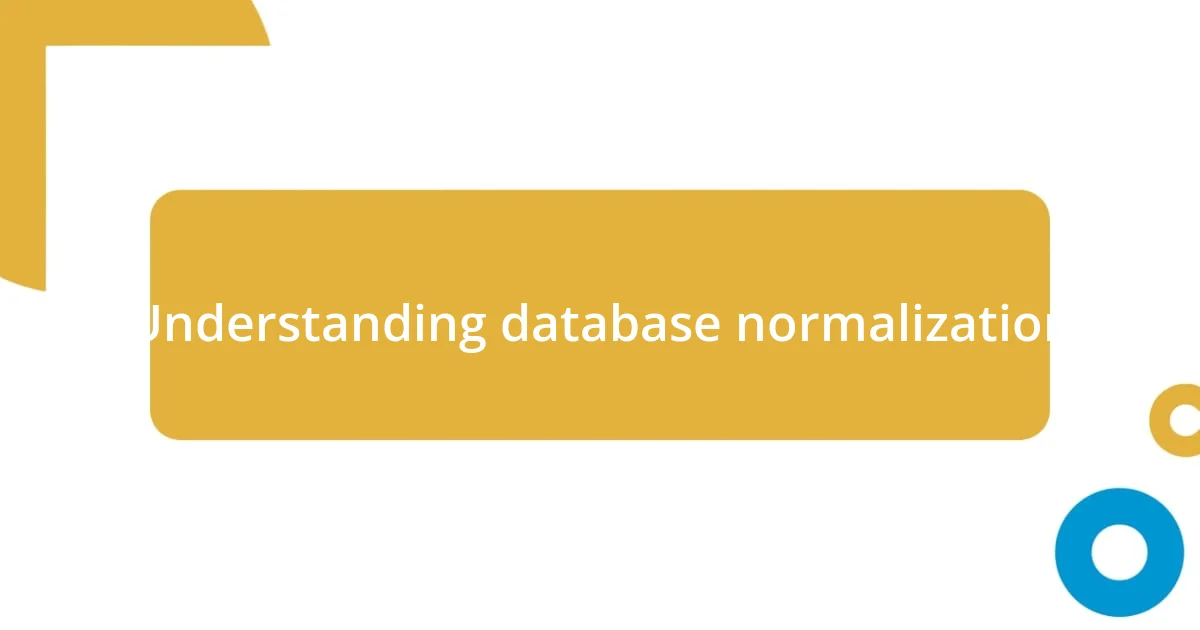
Understanding database normalization
Database normalization is a structured process aimed at organizing a database to reduce redundancy and improve data integrity. I remember tackling a messy database early in my career where duplicate entries were causing confusion. Seeing the chaos firsthand made me appreciate the value of normalization—it’s like tidying up a cluttered room, where suddenly everything has its place.
When diving into normalization, I often find myself asking, “What’s the most efficient way to arrange this data?” This self-questioning leads me to identify the key elements of the data relationships, ensuring that no data point is left in isolation. By embracing the principles of normalization, I’ve learned how to transform a tangled web of data into a clean, efficient structure that supports better decision-making and analysis.
The process typically involves several normal forms, each reducing potential anomalies. I recall how frustrating it was working with a poorly normalized database that led to update anomalies; I would have to correct data in multiple places, risking inconsistency. Now, I approach normalization as a way to create a robust framework, simplifying future data management tasks and ultimately leading to more trustworthy analytics.
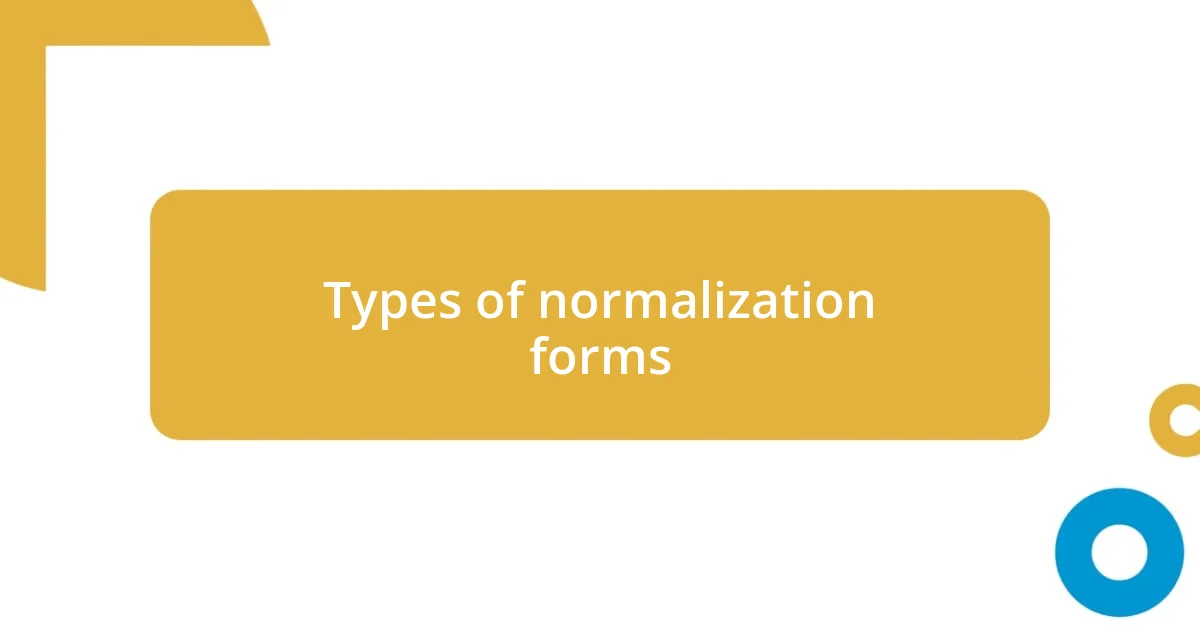
Types of normalization forms
Normalization is categorized into several distinct forms, each building upon the previous one to enhance the structure of the database. When I first learned about these forms, I felt as if I was unlocking new levels in a game. It was fascinating to realize that starting from the first normal form (1NF) up to the fifth (5NF), each level had its own specific focus on reducing redundancy and eliminating the potential for unwanted anomalies. I remember vividly how tackling 3NF, which ensures that all attributes are functionally dependent only on the primary key, opened my eyes to the importance of data dependency.
Here’s a quick overview of the normalization types:
- First Normal Form (1NF): Ensures no repeating groups or arrays within records.
- Second Normal Form (2NF): Builds on 1NF by ensuring all non-key attributes are fully functionally dependent on the primary key.
- Third Normal Form (3NF): Eliminates transitive dependencies, ensuring that non-key attributes depend only on the primary key.
- Boyce-Codd Normal Form (BCNF): A stronger version of 3NF, it addresses certain types of anomaly that 3NF cannot handle.
- Fourth Normal Form (4NF): Focuses on multi-valued dependencies, ensuring that no record depends on more than one set of attributes.
- Fifth Normal Form (5NF): Deals with cases where data can be reconstructed from smaller pieces of information, preventing redundancy.
Each of these forms serves a purpose, guiding the organization of data to ensure that efficiency and clarity reign supreme. It’s like progressing from a simple sketch to a detailed painting—every brushstroke enhances the overall picture.
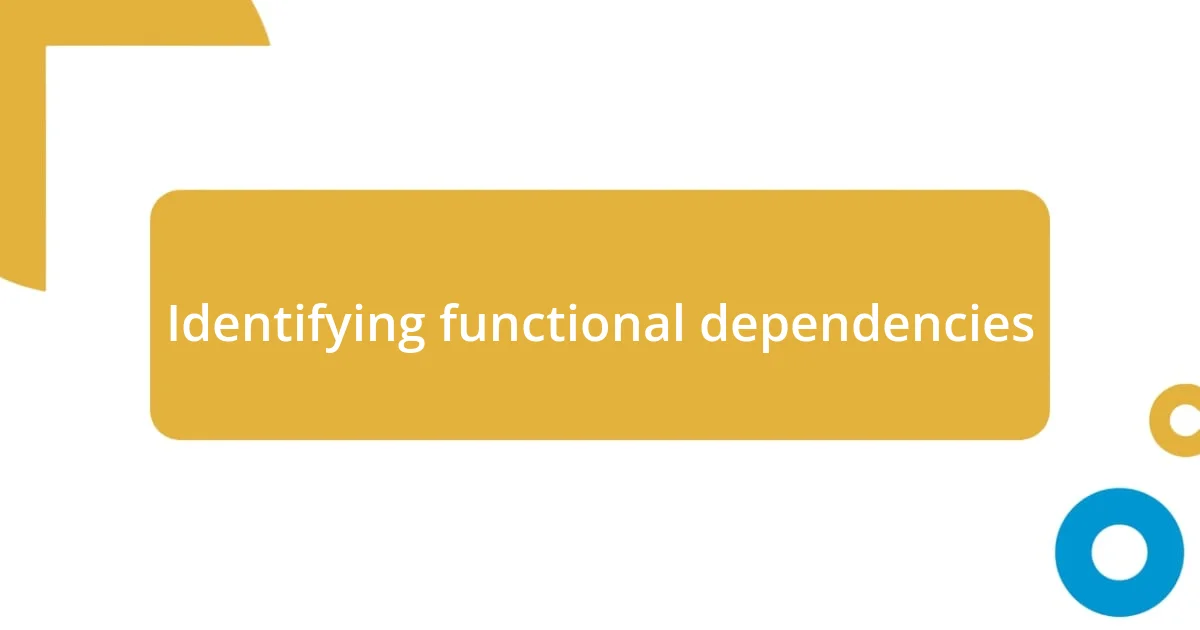
Identifying functional dependencies
Identifying functional dependencies is a foundational step in the normalization process. I find that understanding these dependencies helps paint a clearer picture of how different data points relate to one another. For instance, during a project to redesign a client’s inventory system, I encountered several instances where it wasn’t immediately obvious how some attributes relied on primary keys. Unraveling these connections allowed me to streamline the database, which ultimately enhanced query performance.
It’s not just about seeing dependencies but also about defining them precisely. I remember going through a recent database where a customer’s address was sometimes stored twice, linked to different identifiers. After mapping out the functional dependencies, I realized that the address was functionally dependent on the customer ID, meaning one unique customer ID should point to a single address. This revelation was eye-opening and significantly reduced the redundancy within that database.
Visualizing functional dependencies using tools like dependency diagrams can be incredibly helpful. They provided me clarity in a complex project where many attributes were interwoven. By drawing these connections, I was able to identify unnecessary overlaps in data, making it easier to establish a more normalized structure. This not only enhanced efficiency but also equipped the team with a clearer understanding of how to handle future data management tasks.
| Functional Dependency | Description |
|---|---|
| Uniqueness | Each attribute should be linked to a single identifier. |
| Non-redundancy | Attributes must be functionally dependent on primary keys only to avoid duplication. |
| Transitivity | If A depends on B, and B depends on C, then A shouldn’t depend on C directly. |
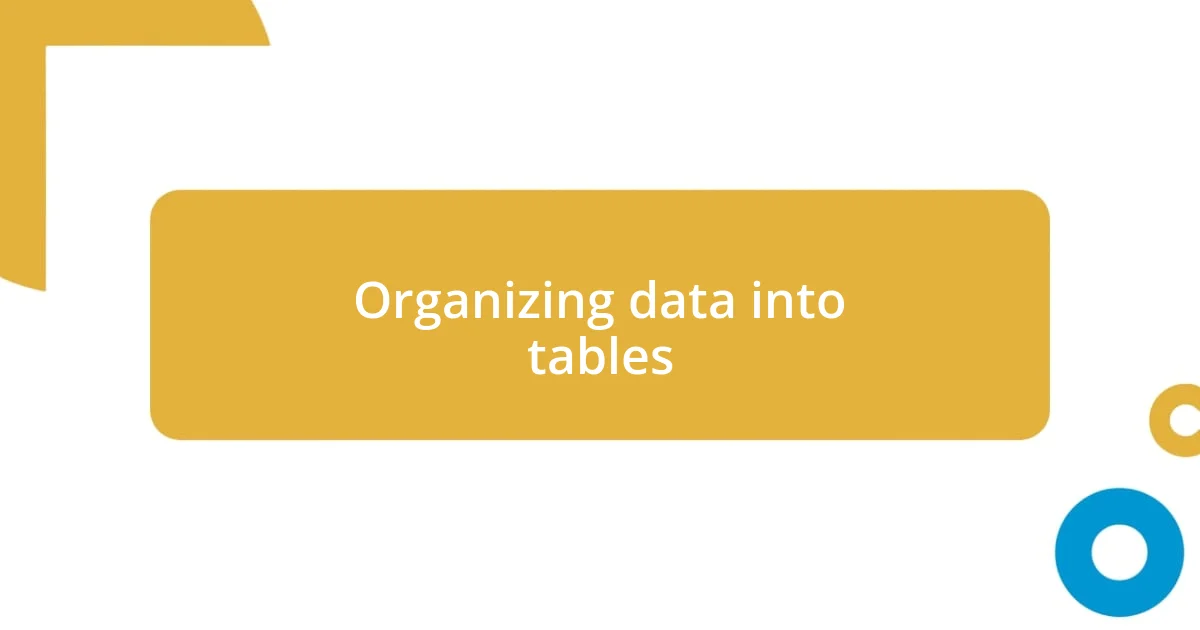
Organizing data into tables
When I approach organizing data into tables, I often think about clarity and simplicity. Each table should represent a single entity, and that keeps my designs clean and easy to navigate. A memorable moment for me was when I was tasked with organizing customer data for a small business. I initially had a massive, unwieldy table filled with mixed information, which made retrieving data a headache. Breaking that data into dedicated tables for customers, orders, and products made everything more manageable.
It’s essential to consider how tables will interact with one another. I once faced a challenge where customer and order data were intertwined in a single table. As I split them into separate entities, I realized how much clearer my relationships became. This separation meant I could now effortlessly run queries for either customer information or orders—a real game-changer in my project. I often ask myself, “How can I make relationships between different data points more straightforward?” The answer, I’ve found, lies in thoughtful table organization.
Additionally, I take time to think about the data types and constraints for each column within my tables. During one project, a colleague overlooked setting constraints for an email field, which led to the inclusion of invalid email addresses. That taught me a valuable lesson: careful table design prevents future headaches. Having appropriate data types and constraints creates an environment where data integrity thrives, ensuring my databases are as reliable as they are efficient.
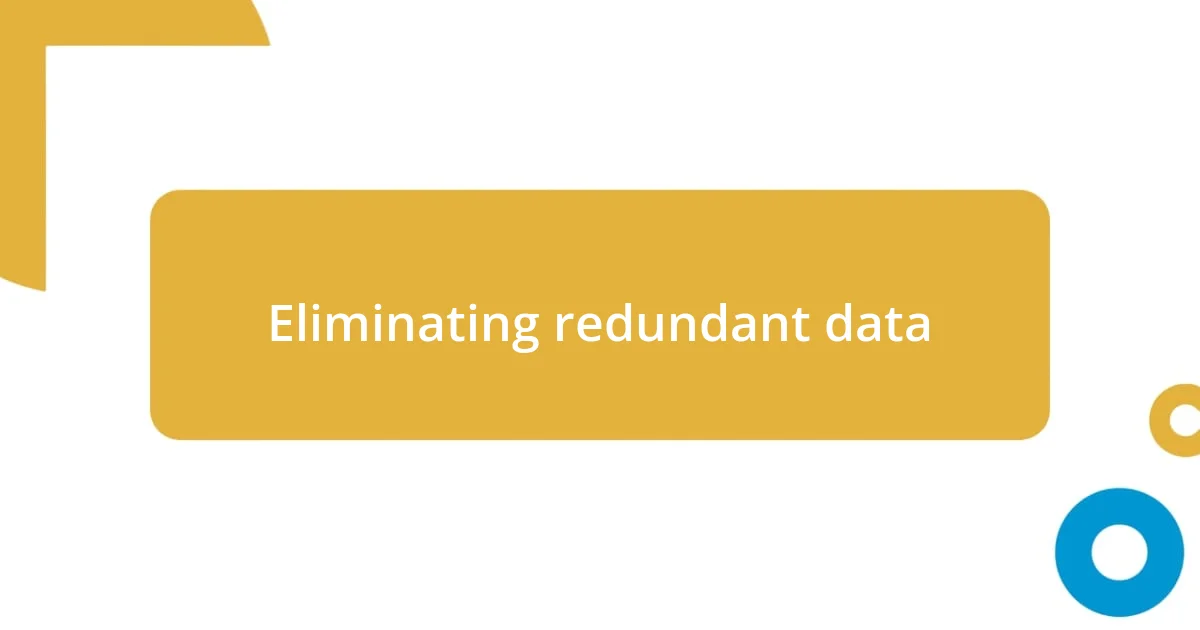
Eliminating redundant data
Eliminating redundancy is a key component of effective database management. I vividly recall the day I discovered duplicate entries in a client’s customer database. It wasn’t just frustrating; it meant that every time I queried that database, I had to sift through mountains of near-identical data. I asked myself, “How can such a simple fix lead to such significant improvements?” By creating a dedicated table for customers and linking relevant data through unique identifiers, I drastically improved the efficiency of data retrieval.
In another instance, while working on a sales database, I noticed that each product had multiple suppliers listed redundantly across different entries. This not only bloated the database size but also made updates a nightmare. Diving into normalization, I established a separate suppliers table, and suddenly, information updates became a breeze. Each supplier was now associated with their respective products through foreign keys. I couldn’t help but feel a sense of accomplishment seeing how simple adjustments could lead to big shifts in database performance.
As I streamlined my databases, I discovered an interesting truth: less really is more. When redundant data is eliminated, not only does it lead to improved storage efficiency, but it also enhances data integrity. I often find myself reflecting on the impact of my choices during the normalization process. The moment I realized that a well-structured database translates to better decision-making for clients was a game changer for me. With each successful normalization venture, I feel a growing desire to share this knowledge with others, empowering them to tackle redundancy in their systems too.
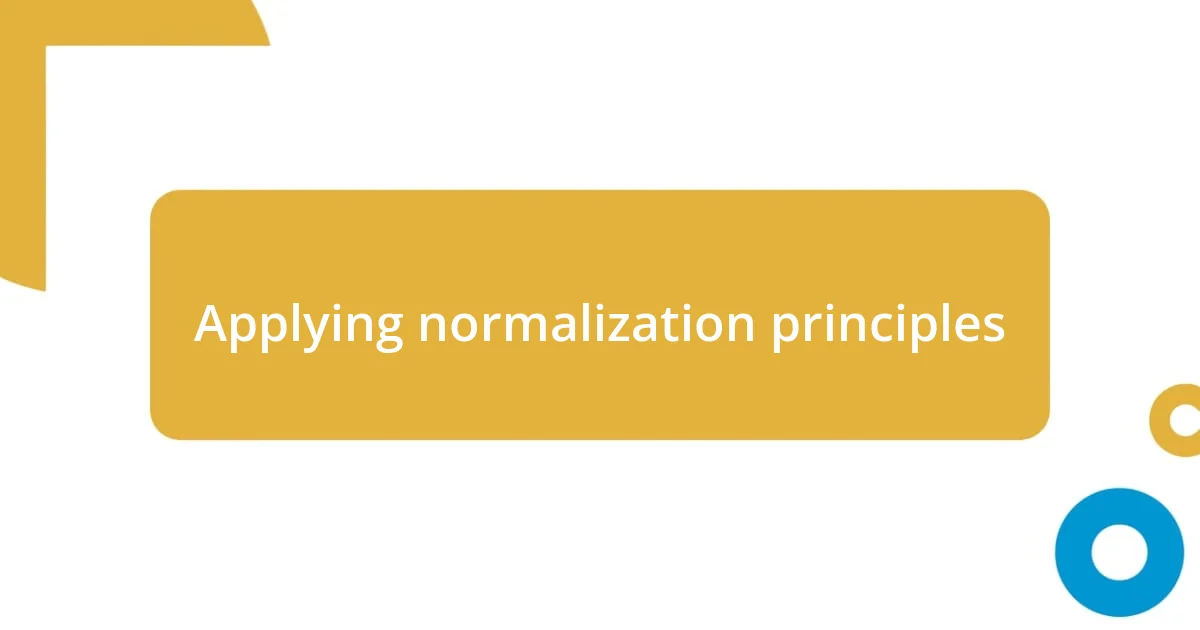
Applying normalization principles
When applying normalization principles, I strive to ensure that each table adheres to specific rules, often starting with the first normal form (1NF). I once tackled a project where initial data had multiple values listed in a single field; it was overwhelming! As I worked through the normalization steps, I learned that breaking those fields into atomic values not only simplified the structure but also made querying data feel like a breeze. Isn’t it amazing how a little structure can bring so much clarity?
Moving on to the second normal form (2NF), I always focus on removing partial dependencies. I recall a time when I spotted a customer table that included order details alongside customer names—what a messy mix! By separating those into distinct tables, I unlocked the potential to run targeted analyses without wading through irrelevant data. This realization raised a thought: How often do we overlook the beauty of clean separations in our work? Trust me, embracing 2NF has made my database interactions far more intuitive.
Finally, considering the third normal form (3NF) is crucial for achieving a deeper level of data integrity. There was a particular scenario where I had a table that listed products alongside supplier address details. The moment I recognized that supplier details should be relocated into their own table, it felt like finding a hidden treasure! That adjustment meant changes to supplier addresses wouldn’t require multiple updates across various tables, reducing the chances of inconsistencies. It made me wonder: could a little foresight in table design lead to a smoother database experience for everyone? It certainly did for me, and I’ve carried that lesson through countless projects since.
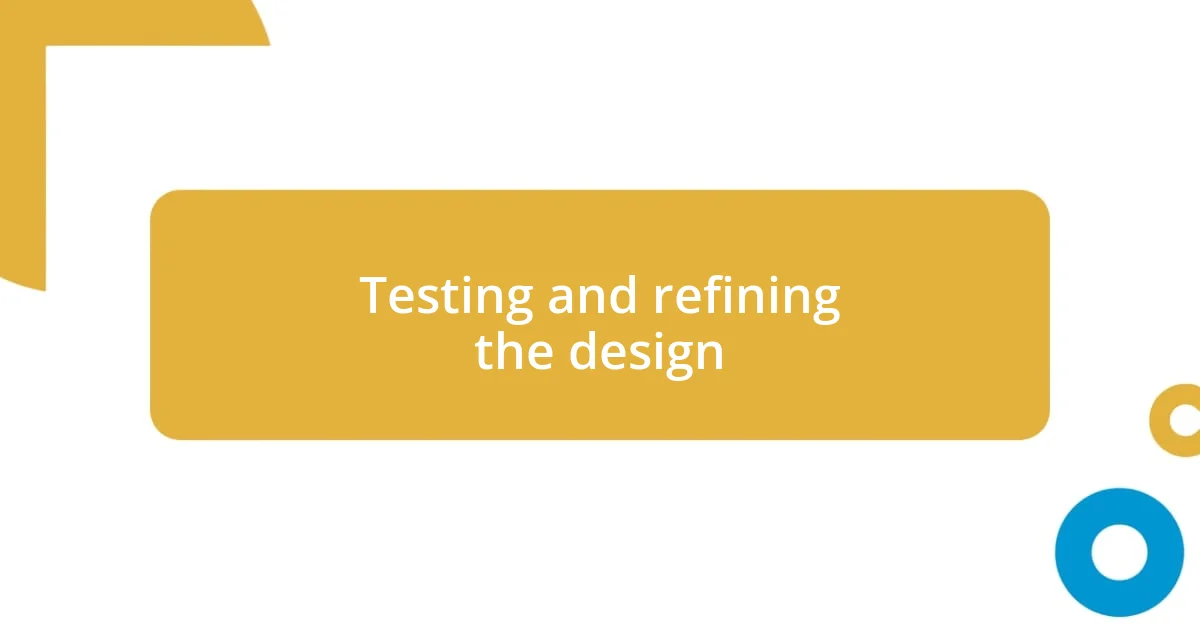
Testing and refining the design
When it comes to testing and refining my database design, I like to hit the ground running with some rigorous testing. For instance, after completing the initial structure, I recall running a series of queries to ensure everything functioned as expected. On one occasion, I unearthed a flaw that would have caused major issues down the line. Discovering that the relationships between my tables weren’t quite as tight as I had imagined was a humbling moment; it highlighted how critical it is to thoroughly vet your design before moving forward.
In my practice, I’ve learned that feedback can be an invaluable tool for refinement. I often involve end-users in the testing process, allowing them to interact with the database. Their insights regularly reveal usability issues I hadn’t even considered. I remember one user commenting on how the layout wasn’t intuitive for navigating supplier data. That simple observation led me to revise my tables and, ultimately, improve the overall user experience. Doesn’t it make you think about how collaborative efforts can enhance our designs?
Once I’ve gathered enough feedback, I dive into the process of refining the structure based on those insights. A memorable instance was when I adapted my previous designs by adding indices to speed up search queries. This seemingly small adjustment resulted in a noticeable boost in performance. What struck me was how just a few tweaks could transform not only the speed but the entire user satisfaction—reminding me that refining isn’t just about fixing issues; it’s about enhancing the experience for everyone involved.














